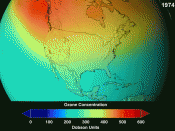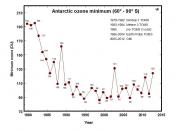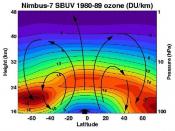Ozone is a triatomic gas that consists of three oxygen atoms. Ozone divides itself into two main categories ÃÂgoodÃÂ ozone and ÃÂbadÃÂ ozone. The ÃÂgoodÃÂ ozone is located in the stratosphere and protects the earth from UV rays. The ÃÂbadÃÂ ozone is harmful pollutant that damages the respiratory system of animals and plants. Ozone by itself is a very corrosive and colourless, gas although in the atmosphere there are different concentrations of it which would have different effects. This essay will talk about the causes and the consequences of these changing concentrations.
In fact, ozone concentration is simplified to be measured by two categories; ÃÂgoodàand ÃÂbadàozone. However, the scientific method of measuring ozone is by using Dobson units or scientist also use part per billion (ppb) or in õg/m3. The ÃÂgoodàozone, or in other words, the ozone layer is located in the stratosphere about 10 to 50km above the earthÃÂs surface.
It filters shorter wavelengths of ultraviolet light. Ozone layer occurs naturally; from the ultraviolet rays that react with oxygen molecules as they are broken up the intense sun. There are five main factors that affect the concentration of the Ozone; the stratospheric sulphate aerosols, stratospheric winds, greenhouse gases, sun spot cycle and the stratospheric chorine.
Stratospheric sulphate aerosols are large explosive volcanoes that can emit a large amount of aerosols gas into the stratosphere. The consequences of these giant volcanoes can be as significant as the Antarctic ozone hole. This is a hole above the Antarctica that has only a very thin ozone layer. Scientists are worried that the hole will expand and then the ice will melt faster and flood the earth.
Stratospheric winds are tropical winds that occur in the lower stratosphere. They change from being easterly to westerly and the back again,


